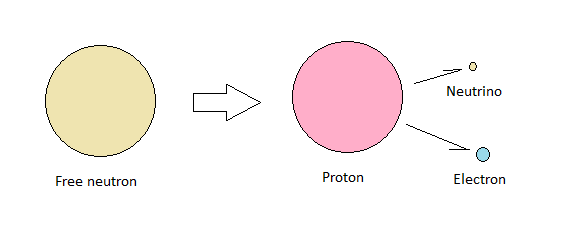Mass is a central concept in physics. Yet, when people go looking for it by…

The Tetraneutron
A tetraneutron is a cluster of four neutrons bundled together. Such clusters were believed to be purely hypothetical, with no chance of existing, so the recent news of their existence means that something is not quite right with current models.
Unstable
The tetraneutron is unstable, with a lifetime of just 3×10-22 seconds. This compares to a single free neutron which has a typical lifespan of about 15 minutes. So, putting neutrons together in clusters is not adding stability.
But why is that so? How is it that atomic nuclei with overall positive charges don’t blow apart, but neutral structures like the free neutron and the tetraneutron do?
The conventional answer is that there are short range forces inside the nucleus that prevent atomic nuclei from falling apart. But, these same forces also prevent neutrons from bundling into neutral structures. However, this explanation is now challenged due to the short lived, but nevertheless real, tetraneutrons.
Alternative explanation
In the alternative physics presented here, the electric force is communicated by an aether. So, there’s no electric force where there’s no aether.
It follows from this that extremely dense matter, where particles are packed densely together, there’s little to no electric force. There’s only texture, a weak, short range force that has properties similar to Velcro.
Atomic nuclei are extremely dense, with little to no aether between components. So, there’s virtually no electric repulsion within them. They can therefore be held together with texture alone.
There’s no need for protons and electrons to be of equal number for this to work. Each electron can attract two protons with texture. They can also pull on nearby protons with the little electric force they still have. Two protons for every electron is therefore a good mix for small nuclei. But larger nuclei require more electrons to keep things together. Hence, the larger relative number of neutrons in larger atomic nuclei.
Neutrons are not fundamental particles
We have small nuclei with roughly equal numbers of protons and neutrons, and we have larger nuclei with somewhat more neutrons than protons. However, our model of the atomic nucleus doesn’t treat neutrons as fundamental particles. Neutrons are modelled as protons with an electron attached to them.
Atomic nuclei are in other words bundles of protons and electrons held together by the affinity that exists between them due to texture.
With little electric repulsion between particles within atomic nuclei, the weak Velcro-like affinity that exist between negative and positive particles is sufficient to keep things together. However, the larger a nucleus becomes, the more important becomes the electric force. This is especially true between the electrons which are like point charges spread out among the much larger protons.
Beta decay
If there are too many electrons in a nucleus, electrons will be ejected by the repelling force of other electrons, and we get what’s known as beta decay. This loss of electrons may in turn cause the nucleus to fall apart for lack of “glue”. When this happens, we have radioactive decay in the form of fission.
Seen in this light, tetraneutron decay is a form of beta decay. The structure decays due to strong repelling forces between electrons. The high number of electrons in the tetraneutron bundle of protons and electrons blows it apart, and texture is only able to keep it together for a tiny fraction of a second before this happens.
Neutron stars
On a related note, we can only wonder at the notion of neutron stars. They are supposedly nothing but giant balls of neutrons held together by gravity. But if a single neutron decays within 15 minutes, and a structure of four neutrons collapses within 3×10-22 seconds, how is it that neutron stars remain stable for millions of years?




Comments (0)